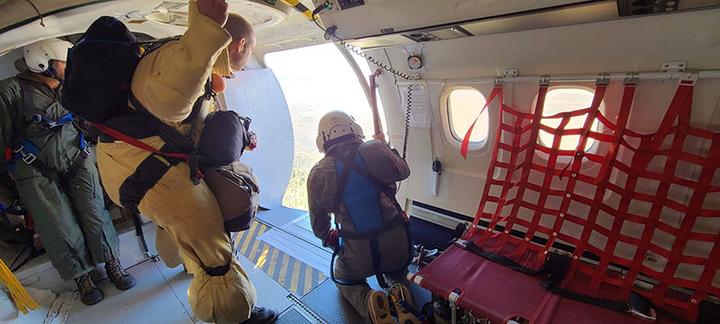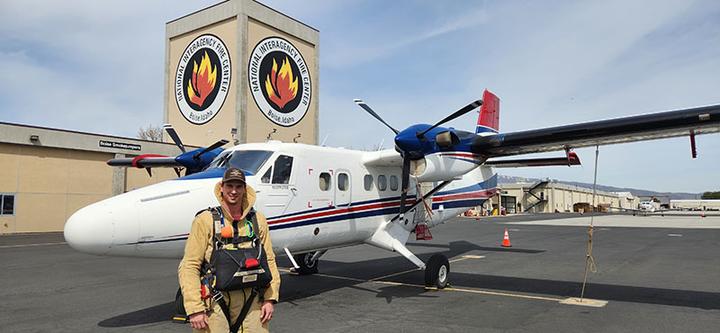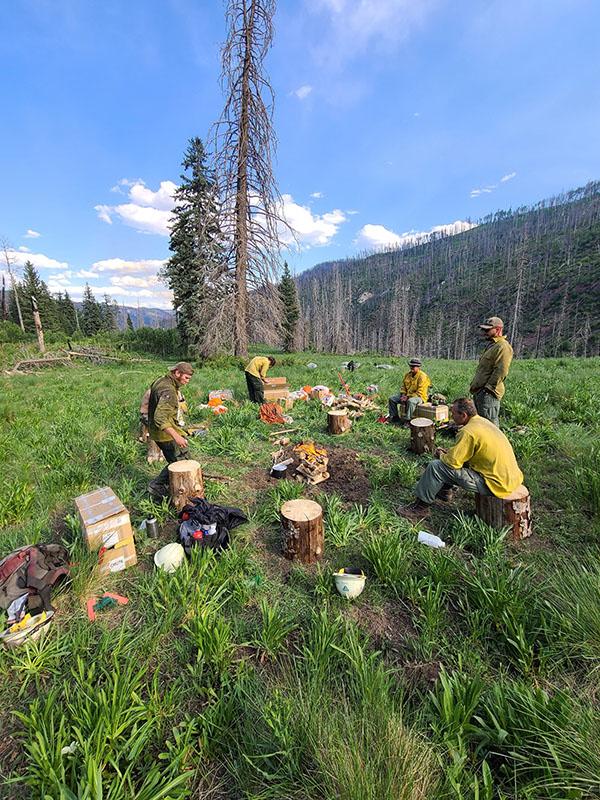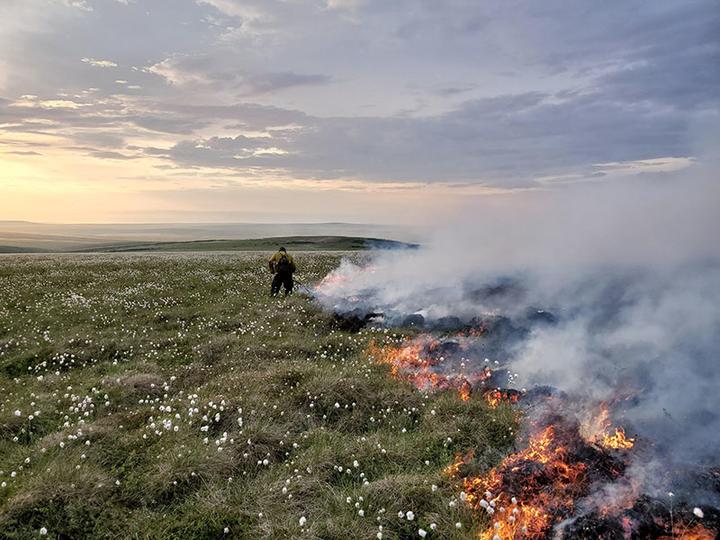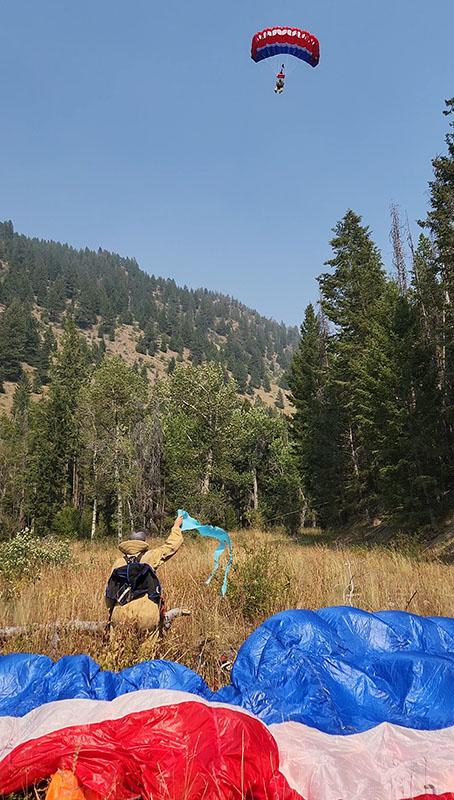
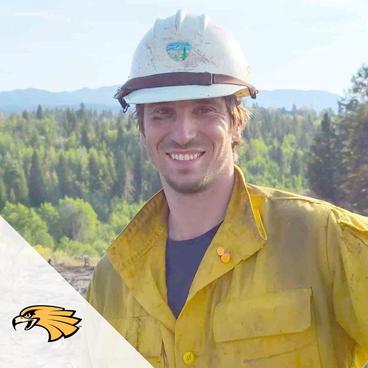
Imagine sitting on the couch watching Netflix and all of a sudden a call comes through. There’s a wildfire raging in the next state and you need to be out the door as soon as possible. You don’t know how long you’ll be gone, and the area you’re going to is mountainous and only accessible by dropping out of an airplane. That’s the life of a smokejumper. Jeff Runck 2012 is working his dream job, and with the support of family and friends, he’s going to keep at it for years to come.
Runck has been a wildland firefighter/smokejumper for over 15 years and his interest peaked as a freshman while attending the University of Minnesota Crookston.
“I had a roommate who worked for the U.S. Forest Service in Montana which is called the Kootenai National Forest, and he got me my first job in fire there that summer,” Runck explained. “That’s where the inspiration for my current career began.”
Each consecutive year Runck went back to the same base and fought fire, and every year he applied to get on a “Hotshot crew” to earn enough time and experience to apply to be a smokejumper.
“It was hard for Hotshot crews to take on students as they wanted to get people during parts of the school year,” said Runck. “I was committed to finishing school and graduating.”
Runck did what he set out to do and graduated with a bachelor of science degree in natural resources, but not without additional support from his professors who wrote their final exams early so he could show up for the start of training on the Hotshot crew.
“The Idaho City Hotshots’ season (near Boise, Idaho) would start April 7 and graduation at UMC in 2012 was the first week in May, so I talked to my professors Phil Baird, John Loegering, Tom Feiro, and others for their support,” he recalled. “I wouldn’t have been able to go out and work that year on that crew without those instructors, and those that went to bat for me.”
Following graduation Runck worked for the Idaho City Hotshots and later went to Pheasants Forever for a year, but missed fire so much he went back to the Hotshot crew in 2014. After the 2014 and 2015 fire seasons, Runck continued to apply to smokejump. Typically it takes interested parties many years of fire experience before they’re selected to go to rookie camp training. Runck was selected by the Bureau Land Management Great Basin Smokejumpers and rookied in 2016. It was a dream come true for Runck and he’s still with them to this day serving as a GS-9 Loft Technician and FAA licensed Master Parachute Rigger. Additionally, Runck is rostered on a regional incident management team (Great Basin IMT 5) serving as a Division Supervisor.
“Smoke jumping is primarily an initial attack resource, first ones on scene, all the fires that you almost never hear about they put them out before they become a problem,” Runck explained. “We get a call and get on a plane and fly to it. We get people, highly trained firefighters, on the ground as fast as possible.”
“This is something that started as a project with the forest service back in 1939 and is still going today,” he added.
Runck has seen a lot of activity in the Great Basin and has traveled to fight fires in Alaska, Idaho, Montana, Wyoming, and Colorado. Being at one of nine smokejumper bases in America, there are also opportunities that arise to fight fires in California, Oregon, and Washington. Firefighting and smokejumping are unpredictable jobs, and Runck said that’s what makes it ‘exciting’. Runck’s last fire jump was out of Cedar City, Utah, at a ‘new start’ by Great Basin National Park at the Utah Nevada state lines. The fire was burning up about 8,500 feet.
“We’re primarily useful for fires that aren’t accessible and burning in remote areas,” Runck defined. “We can and will jump accessible fires on roads for incidents that are emerging or growing larger and more complex. When we get to the ground many of the jumpers will get placed into an overhead supervision role, or IC (incident commander) to help with suppressing the fire. There've been a lot of fires this year burning on steep rocky knife ridges, or in a bowl, and the best tactic is chainsaw removal of the fuels around the perimeter. ie. we’re cutting out a lot of Pinyon pine and Juniper trees.”
“We don’t carry water to suppress fire, we can have pumps ordered or have them brought to us by planes or helicopter, or driven to the nearest road,” he added. “That (particular) fire, we used helicopters for water as they got us bucket drops. We have heavy support from aerial resources. Once we get to the ground, our airplane comes over and kicks out paracargo. This includes food, water, hand tools, chainsaws, and gasoline to get us going for the first 48 hours, and then you’d have to order anything else over the radio through dispatch.”
The chaotic situation, to Runck, is “so fun.”
“Pretty sure there’s a fire every day in the U.S.,” Runck continued. “A fire 100 acres or larger makes the national fire situation report which can be found online and it tells you how many people are assigned to that fire, what resources they’re using like helicopters, and it even tallies the estimated cost. We use that report every day to brief on the national situation.”
The largest fire Runck has been a part of was in Quebec, Canada and was 1.5 million acres in size. Depending on the weather, winter season, and moisture levels, countries may ask for global support, which Runck has participated in.
“Alberta has about one percent of the world’s forests just in that province, so when it’s dry and you get lightning and winds, it’s hard to keep fires small,” Runck explained. “Places like Alberta, they’re not fully equipped, so they ask for support from the U.S., Korea, South Africa, Europe, and other countries.”
Through all challenges and chaos, Runck still ends the day happy with his career.
“Smokejumping has been the most challenging thing I’ve ever done in my life and probably will ever do,” he admitted. “It’s brought out a new side of me. The places you get to go to nobody else will get to go, especially when really the only way in there is by parachute and a helicopter ride out.”

“The biggest thing I’ve learned is being able to manage fear and channel that energy to make good decisions, compartmentalize, and take one step at a time,” Runck went on. “There’s a lot of responsibility on us to make good decisions. If you have a bad jump, you can get hurt pretty seriously. It’s important to learn from every jump and to consolidate actions you did well, and things you could improve on for the next one. It’s all about developing as many slides as you can. Frequent training and experience are what keeps us safe. There have been fatalities. We do training every spring plus refreshers. It takes a special person to see beyond that and be okay with dropping everything for six months of your life, and choosing to protect the natural resources we have, the communities, and wildlife.”
Runck acknowledged even he, every once in a while, needs a day off to decompress.
“For every firefighter, it’s important to have a good family life and support system,” he added. “I have a good support system and a supportive wife. The families who are attached to individuals that have that kind of career ultimately become part of that lifestyle as well. Their support is completely crucial.”
The U.S. Forest Service and The Bureau of Land Management are celebrating 80+ years of smokejumping history fighting wildland fires in 2023 and have approximately 320 smokejumpers that work from Nine bases located in: Boise, Idaho, Grangeville, Idaho; McCall, Idaho; Missoula, Montana; Redding, California; Redmond, Oregon; West Yellowstone, Montana; Fairbanks Alaska, and Winthrop, Washington.
Written for the Fall 2023 Torchlight e-Newsletter
